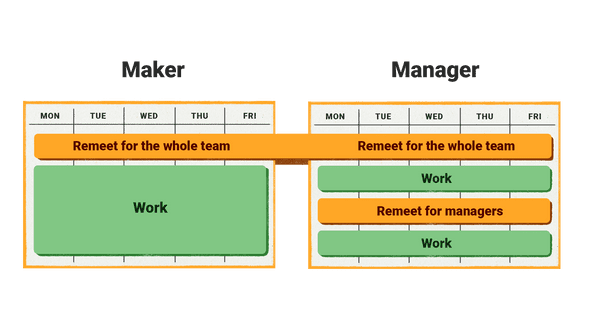Reverse Meetings with Remeet
Hi there!
I’ve just read this post from Cal Newport called Combating Zoom Overload with Reverse Meetings.
I immediately felt excitement. I thought, “This is exactly what we’ve built with Remeet! Hmm, does Remeet stand for Reverse meetings? This blog post would be a perfect fit for our website!”
So I’ve decided to write a quick post that explains how your team can implement Reverse Meetings with Remeet. If you haven’t read Cal’s post above, make sure you do so you can see how reverse meetings can benefit your team.
To start, teams agree on a daily Remeet office hour. In an ideal scenario, it’s the same hour every day like this:
Bigger teams may have a few additional Remeet office hours for managers to talk with other managers:
After that initial setup is done, all you need to do is just type “Discuss something with @nancy @peter 10min” on Slack, and that discussion will be scheduled during the next available Remeet office hour.
Now, you may say that this is not really a Reverse Meeting as this requires a prior appointment. But in practice, the difference is a very minor implementation detail as the scheduling on Remeet is highly dynamic, and those appointments move all the time. Here’s how they are different from your regular calendar appointments:
- You don’t need participants to approve/accept Remeet’s appointments as they already indicated their availability for the whole hour.
- Appointments freeze only 15 minutes before the start of Remeet office hour. So if your daily office hour is at 10 am, things can change up until 9:45 am.
- Anyone can type something like “Production incident with @john @terry 15minute very urgent.” Making something very urgent will automatically postpone everything else that has been already planned.
There are two additional upsides of Remeet’s implementation:
- You’ll never have to wait in line when someone is finishing a discussion. We show everyone that you have a hard stop, and we automatically transition everyone to the next topic as soon as it starts. As a result, most people join within the first 5 seconds.
- Every discussion has its time budget, and it won’t suffer from Parkinson’s Law. Otherwise, the first two 10 minute topics may consume the whole hour. As a result, about 70% of Remeet meetings are around 10 minutes (out of thousands).
This is how our customers flow through single-topic meetings during their Remeet office hours:
It’s pretty common to see time savings from 20-25 hours a week to less than 10 hours or from 10-15 to less than 5.
You can read more about all the other benefits here.

